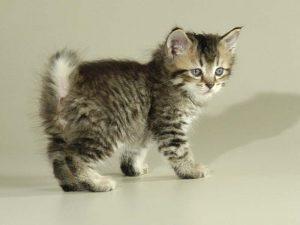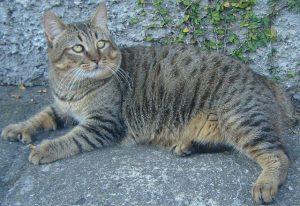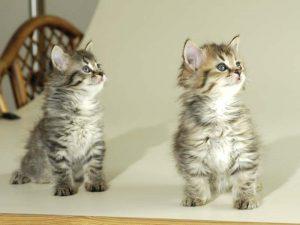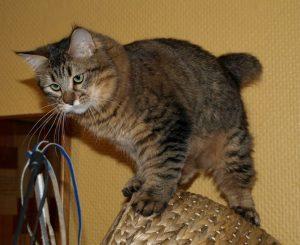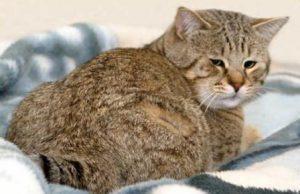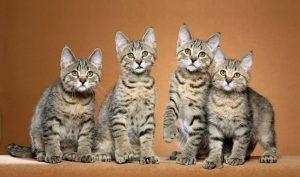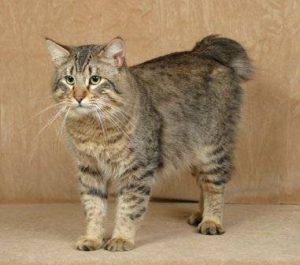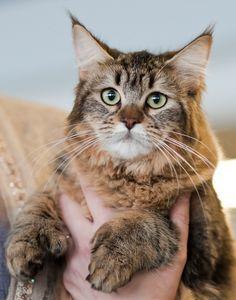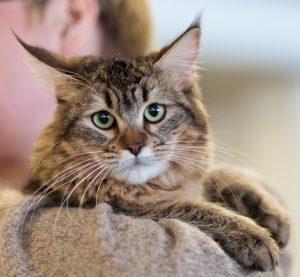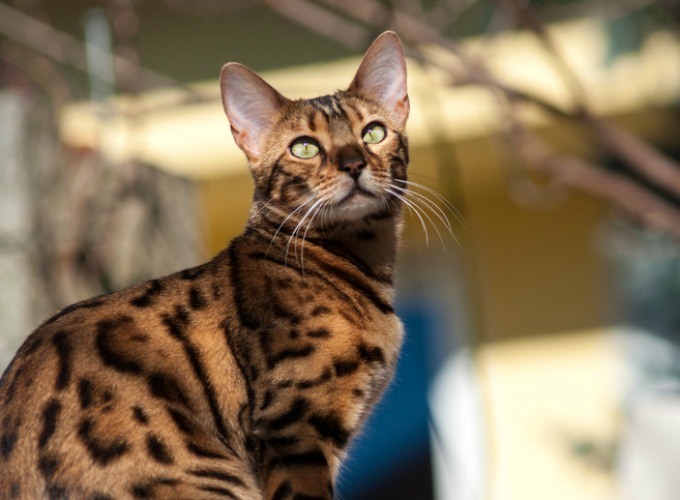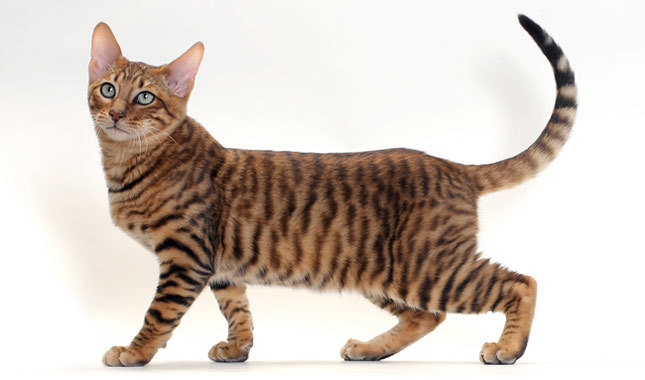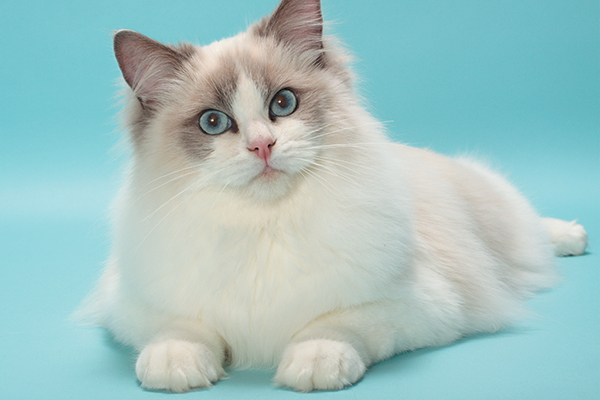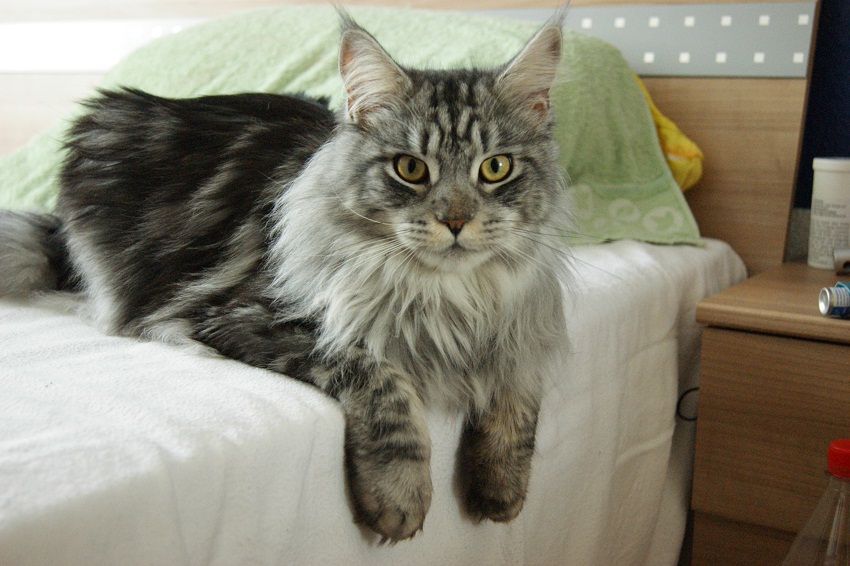The Pixie-Bob cat is a breed of North American domestic felines that are known for their bobcat-look, intelligence, and affectionate personality. Their breeding standard demands that these cats must not cross with other breeds, except for ‘legend cats’ (a term coined by the breed founder for those cats which she believed were born from naturally-occurring mating between domestic and North American bobcats).
Quick Information
Physical Appearance & Size
| Size Category: | Large |
| Body Type: | Muscled structure with a slightly convex profile; have a roundish face, triangular eyes, broad nose and straight ears |
| Weight: | Male:12-17 pounds; Female: 8-12 pounds |
| Height: | 10-12 inches (full grown) |
Colors & Patterns
| Coat Type: | Short, long, soft, silky, with light undercoat; spotted or tabby-patterned |
| Tail Type: | Can be born with or without a tail, but can also be short-tailed |
| Eye Color: | Kittens are born with blue eyes that change to green or gold with age |
Other Characteristics
| Life Expectancy (Lifespan): | 13-16 years |
| Characteristics/Qualities: | Loving, intelligent, social, active |
| Availability: | Relatively rare |
| Lap Cat: | Yes |
| Shedding: | Frequent |
| Good with Children: | Yes |
| Good with Pets (Other Cats): | Yes |
| Vocalization/ Noises: | Yes |
| Hypoallergenic: | No |
| Attention Seeker: | Yes |
| Countries of Origin: | Washington, USA |
History and Development
The Pixie-bob was developed in the USA in the spring of 1985 by a breeder named Carol Ann Brewer from Washington. A beautiful female kitten with muted spotting, a reddish fawn coat, and a wild look was born in a litter parented by a male cat belonging to Brewer, and a female, which was owned by a neighbor. Brewer named the kitten ‘Pixie’. It was this Pixie that served as the foundation of the Pixie-Bob breed.
Though some people claim that this breed developed from an accidental mating between a wild bobcat and a domestic feline, DNA testing did not detect any bobcat marker genes. They believe that Pixie-bobs were established with an aim to breed bobcat lookalikes.
In 1993, Carol Ann approached TICA to get her breed recognized, following which, it got the Exhibition Status in 1994. In 1995, the Pixie-Bob breed was accepted by TICA as a ‘new breed’, and in 1997, it received the Championship Status.
Temperament and Personality
- Highly sociable and loves mixing not only with owners but also strangers
- Friendly with other animals and love playing with other pets
- Has an affinity for water
- The level of intelligence is high, with the ability to even understand some human words and phrases
- Doesn’t prefer the outdoors, though quite active, following its owner from room to room, and being in the same room with him
- They are known to chatter and emit chirps and growls; most individuals rarely meow, others do not meow at all
Who is the Pixie-Bob Good For
- Those who do not mind their cat following them all the time
- Owners who love to sleep cuddling with their pets
- People who are looking for a playful cat
- Those who want some vocal interaction with their pets
Care
Most cats are short-haired, though a few specimens can be long-haired. Either way, they are okay with moderate grooming. Since they shed quite often, brushing their coat 3-4 times a week is required to keep them well-groomed and free from dead hair.
Being outcrossed with the ‘legend cats’, they have a diverse genetic pool, and hence, there is no record of any breed-specific diseases. However, very rare cases of a few genetic diseases (Hypertrophic Cardiomyopathy, Cryptorchidism, and Dystocia) have been observed by breeders since its development.
Are they Easy to Train
Being intelligent, Pixies would catch your words and learn commands very easily. You can also effectively train them to walk on the leash, fetching things for you, and a few other tricks including ball fetching, head butting, etc.
Diet/Feeding
Give them high-quality premium brand dry kibble available in the pet stores.

